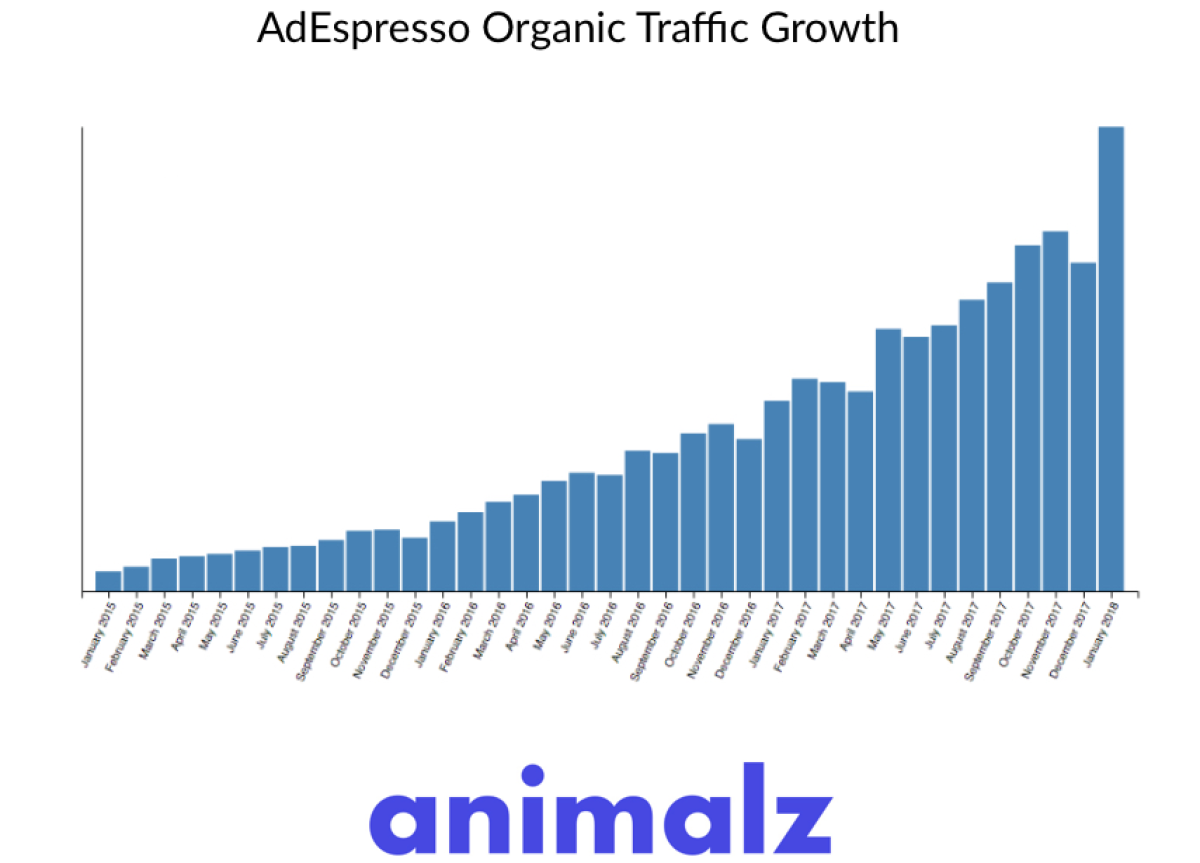For all the advice out there on “growing an audience” and “leveling up your content,” there's precious little about the real-world hurdles of writing content that someone might actually want to read.
It's hard to produce great content. Lightweight and uninteresting content can often be traced back to bad process or misaligned incentives. We'll unpack a few trends that can get in the way of great work and offer some advice for righting the ship.
1. You're Addicted to the Traffic Dopamine Hit
Thesurge of trafficthat a new article generates can be addicting. So addicting that many companies never take their foot off the gas long enough to consider whether their strategy is actually working.
We've covered in detail the differences between a publication approach and a library approach to content (article,podcast), but we can sum it up here: Treating your blog like a publication results in too much content being produced. The cadence means that your content team can't possibly maintain the quality and depth required to win traffic.
You might consider an aggressive editorial calendar to be a bold approach. We'd argue that it's a hedge against your confidence in a real content strategy.
Domino's Pizza CEO Patrick Doyle, who oversawthe company's 90x stock price increase, says that overcoming loss aversion waskey to the turnaround: “The pain of losing is twice the happiness of winning,” he argues, “so people tend to be cautious. But in spite of these huge risks, they pulled the trigger because everyone on the team believed it was the right move.”
In order to scale traffic, you have to let go of the traffic dopamine hit. Steady growth is unsexy. AdEspresso,one of the most successful content operations we've come across, grew organic traffic 9.79% per month for three years. That propelled the site from 84,000 pageviews in January 2015 to more than 10x that three years later.

Their strategy is all about driving organic growth, something that happens slowly. We recommend setting monthly traffic goals, forecasting the next few years, and then building a content strategy that gets you there.
The simple act of checking in each month to see whether you've hit a very specific goal is a great way to make sure your work is focused on improving those numbers.
2. Content Isn't Baked Into the Company Culture
If the content team works in a silo, lacks domain expertise, and is incentivized only to grow pageviews, quality will never improve.
To better understand this challenge, here's a snippet from Ben Thompson'sThe Curse of Culture:
Culture is not something that begets success, rather, it is a product of it. All companies start with the espoused beliefs and values of their founder(s), but until those beliefs and values are proven correct and successful they are open to debate and change. If, though, they lead to real sustained success, then those values and beliefs slip from the conscious to the unconscious, and it is this transformation that allows companies to maintain the “secret sauce” that drove their initial success even as they scale.
This framework makes perfect sense in the context of popular SaaS and tech blogs.
Leo Widrich and Joel Gascoigne were writing about Buffer on day one. They were transparent about the revenue and salaries. The blog took off, reinforcing the idea that sharing the company's story is important. Content is now baked into their culture.
Intercom cofounder Des Traynorwrote 93 of the company's first 100 blog posts. Writing was not something he did on the side; it was (and is) part of his job. And since it worked well, content is prioritized all around the company. Managers actually encourage developers, designers, and product folks to write. New hires expect to write. The content team facilitates the process, but every post is penned by someone with domain expertise. Content is baked deeply into the culture.
First Round Review handed the reins to an experienced professional, Camille Ricketts. The leadership team's trust in her set the tone for anyone and everyone who touched First Round content. Even though she's moved on, the content is still great, thanks to the imprint she left.
Building acontent marketing cultureis easiest when founders start blogging early on. Companies that start later tend to treat it differently. They're more interested in quarterly projections andmonth-over-month growth. There's nothing inherently wrong with this, but a sharp focus on metrics often leads to prioritizing short-term tactics instead of long-term strategies. It's not a matter of bad intentions, just misaligned incentives.
Regardless of your current content culture, here are a few recommendations to make sure it's still an effective marketing channel.
Make sure you have:
an experienced content marketing lead with total buy-in from leadership;
an explicit acknowledgment that it will take months or years to see a return;
an agreement on the key metrics you'll measure;
a budget to hire or outsourcecontent creation, with the understanding that quality isn't cheap;
a keenfocus on SEO—this is your leverage point; and
a clearly articulatedcontent strategy.
Thequality of the content you createimproves quickly when the pressure to achieve a few short-term wins is alleviated.
3. People with Domain Expertise Aren't Writing
This is the fundamental challenge of content marketing. The experienced engineer isn't interested in writing, the thoughtful CEO has no time, and the designer isn't sure anyone would care about her words.
When content that requires subject-matter expertise is tasked to someone without it, two things happen:
Too much content gets produced. The lack of a solid content strategy and the absence of really great ideas to write about are compensated for with volume.
Your content looks like everyone else's content. Junior-level content marketers aren't yet able to differentiate, so they mirror what successful sites do.
Nearly every company faces this challenge, and there are a few ways to handle it.
Facilitate Writing by Internal Subject-Matter Experts
This is the path chosen by one of the most well-respected content producers in the SaaS world: Intercom. Their content team is tasked primarily with helping the company's developers, product managers, and salespeople write blog posts on the topics they know best.
As we wrote in our interview with Intercom editor Geoffrey Keating, when the writers are also the practitioners, your content immediately stands out.
Geoffrey admitted that this is a challenging way to grow a blog—hence our title for the post,How to Grow a Blog the Hard Way—but also noted that once his nonwriting colleagues contributed to the blog for the first time, they were often eager to do it again. Over the years, more than 200 people have contributed to the blog, and many of the posts have been smash hits.
If you choose to go this direction, Geoffrey suggests the following:
Ask contributors to write an elevator pitch, and then help themturn the idea into an outline.
Pin the elevator pitch to the top of the document where they'll write so they'll have a “North Star” to follow.
Don't ask nonwriters to adopt your systems and processes. Make it as seamless as possible for them to contribute.
Schedule face-to-face meetings to discuss feedback on their work. Filling a doc with comments is overwhelming to someone who doesn't write for a living.
When their post goes live, celebrate their work, and make sure the post gets shared around the company.
To be sure, this is a challenging approach. But as Intercom can attest, it works.
Find Your Own Source Material
If you're a content marketer writing about topics that you don't know intimately, you need to find ways to get your own source material. Without new and proprietary information, you'll almost certainly end up regurgitating what others have already said.
There are two ways we suggest going about this:
Run experiments.This allows you to collect your own dataandget hands-on experience doing the thing you're teaching others how to do. An AdEspresso article—Buying Instagram Followers? Our Experiment Reveals The Truth…—is a perfect example of this strategy in action. (It works too; this post has been read more than 100,000 times.)
Interview experts.Find people who know a lot about the topics you're covering, and then interview them. Ask specific questions and lots of follow-up questions. Don't look just to “influencers”—try to find an author or a professor who is willing to chat. When it comes time to publish, weave their words into a narrative that is compelling for the reader you're trying to reach.
Don't settle for content that merelylooks and feelslike content—find ways to share substance.
Set a High Bar
Before you commit to acontent strategy for 2019, ask yourself, “How can we produce more content that people will be genuinely interested in?” Content that achieves that will more easily rank in search and spread on social media.
Need a hand with ideas and execution?Contact usto set up a time to chat.
